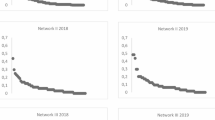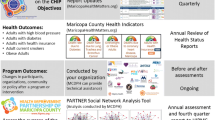Abstract
Our objective was to identify agency-level factors that increase collaborative relationships between agencies that serve children with complex chronic conditions (CCC). We hypothesized that an agency will collaborate with more partners in the network if the agency had a coordinator and participated in a community coalition. We surveyed representatives of 63 agencies that serve children with CCC in Forsyth County, North Carolina about their agencies’ collaborations with other agencies. We used social network analytical methods and exponential random graph analysis to identify factors associated with collaboration among agencies. The unit of analysis was the collaborative tie (n = 3,658) between agencies in the network. Agencies participating in a community coalition were 1.5 times more likely to report collaboration than agencies that did not participate in a coalition. Presence of a coordinator in an agency was not associated with the number of collaborative relationships. Agencies in existence for a longer duration (≥11 vs. ≤10 years; adjusted odds ratio (aOR): 2.1) and those with a higher proportion of CCC clientele (aOR: 2.1 and 1.6 for 11–30 % and ≥31 % compared to ≤10 %) had greater collaboration. Care coordination agencies and pediatric practices reported more collaborative relationships than subspecialty clinics, home-health agencies, durable medical equipment companies, educational programs and family-support services. Collaborative relationships between agencies that serve children with CCC are increased by coalition participation, longer existence and higher CCC clientele. Future studies should evaluate whether interventions to improve collaborations among agencies will improve clinical outcomes of children with CCC.

Similar content being viewed by others
References
McPherson, M., Weissman, G., Strickland, B. B., et al. (2004). Implementing community-based systems of services for children and youths with special health care needs: How well are we doing? Pediatrics, 113(5 Suppl), 1538–1544.
Child and Adolescent Health Measurement Initiative. (2005). National Survey of Children’s Health, Data Resource Center on Child and Adolescent Health website. www.nschdata.org. Accessed 05 July 2006.
Kuo, D. Z., Cohen, E., Agrawal, R., et al. (2011). A national profile of caregiver challenges among more medically complex children with special health care needs. Archives of Pediatrics and Adolescent Medicine, 165(11), 1020–1026. doi:10.1001/archpediatrics.2011.172.
Feudtner, C., Christakis, D. A., & Connell, F. A. (2000). Pediatric deaths attributable to complex chronic conditions: A population-based study of Washington State, 1980–1997. Pediatrics, 106(1 Pt 2), 205–209.
Srivastava, R., Stone, B. L., & Murphy, N. A. (2005). Hospitalist care of the medically complex child. Pediatric Clinics of North America, 52(4), 1165–1187. doi:10.1016/j.pcl.2005.03.007.
Cohen, E., Kuo, D. Z., Agrawal, R., et al. (2011). Children with medical complexity: An emerging population for clinical and research initiatives. Pediatrics, 127(3), 529–538. doi:10.1542/peds.2010-0910.
Buescher, P. A., Whitmire, J. T., Brunssen, S., et al. (2006). Children who are medically fragile in North Carolina: Using Medicaid data to estimate prevalence and medical care costs in 2004. Maternal and Child Health Journal, 10(5), 461–466. doi:10.1007/s10995-006-0081-3.
Berry, J. G., Hall, D. E., Kuo, D. Z., et al. (2011). Hospital utilization and characteristics of patients experiencing recurrent readmissions within children’s hospitals. Journal of the American Medical Association, 305(7), 682–690. doi:10.1001/jama.2011.122.
Simon, T. D., Berry, J., Feudtner, C., et al. (2010). Children with complex chronic conditions in inpatient hospital settings in the United States. Pediatrics, 126(4), 647–655. doi:10.1542/peds.2009-3266.
Neff, J. M., Sharp, V. L., Muldoon, J., et al. (2004). Profile of medical charges for children by health status group and severity level in a Washington State Health Plan. Health Series Research, 39(1), 73–89. doi:10.1111/j.1475-6773.2004.00216.x.
Taylor, E., Lake, T., Nysenbaum, J., Peterson, G., & Myers, D. (2011). Coordinated care in the medical neighborhood: Critical components and available mechanisms. White paper (prepared by mathematica policy research under contract no. HHSA290200900019I TO2). AHRQ Publication No. 11-0064. Rockville, MD: Agency for Healthcare Research and Quality.
U.S. Department of Health and Human Services. Office of Disease Prevention and Health Promotion. Healthy People 2020. Washington, DC. Available at [Specific URL]. Accessed 26 April 2012.
Scott, J., Tallia, A., Crosson, J. C., et al. (2005). Social network analysis as an analytic tool for interaction patterns in primary care practices. Annals of Family Medicine, 3(5), 443–448.
Kwait, J., Valente, T. W., & Celentano, D. D. (2001). Interorganizational relationships among HIV/AIDS service organizations in Baltimore: A network analysis. Journal of Urban Health, 78(3), 468–487.
Keating, N. L., Ayanian, J. Z., Cleary, P. D., et al. (2007). Factors affecting influential discussions among physicians: A social network analysis of a primary care practice. Journal of General Internal Medicine, 22(6), 794–798.
Hawe, P., Webster, C., & Shiell, A. (2004). A glossary of terms for navigating the field of social network analysis. Journal of Epidemiology and Community Health, 58(12), 971–975.
Farmer, J. E., Clark, M. J., Sherman, A., et al. (2005). Comprehensive primary care for children with special health care needs in rural areas. Pediatrics, 116(3), 649–656.
Palfrey, J. S., Sofis, L. A., Davidson, E. J., et al. (2004). The pediatric alliance for coordinated care: Evaluation of a medical home model. Pediatrics, 113(5 Suppl), 1507–1516.
Kreuter, M. W., Lezin, N. A., & Young, L. A. (2000). Evaluating community-based collaborative mechanisms: Implications for practitioners. Health Promotion Practice, 1(1), 47–61.
National Hospice and Palliative Care Organization. (2004). Caring for kids: How to Develop a Home-Based Support Program for Children and Adolescents with Life-Threatening Conditions. Alexandria, VA: National Hospice and Palliative Care Organization.
Nageswaran, S., Ip, E., Golden, & S. L., et al. (2012). Inter-agency collaboraiton in the care of children with complex chronic conditions. Academic Pediatrics.
U.S. Census Bureau (2010). State and County QuickFacts. Data derived from Population Estimates, American Community Survey, Census of Population and Housing, State and County Housing Unit Estimates, County Business Patterns, Nonemployer Statistics, Economic Census, Survey of Business Owners, Building Permits, Consolidated Federal Funds Report. http://quickfacts.census.gov/qfd/states/00000.html. Accessed 26 April 2012.
Friedman, S. R., Reynolds, J., Quan, M. A., et al. (2007). Measuring changes in interagency collaboration: An examination of the Bridgeport safe start initiative. Evaluation and Program Planning, 30(3), 294–306.
Network Genie. (2011). Tanglewood research incorporated. https://secure.networkgenie.com/.
Luke, D. A., & Harris, J. K. (2007). Network analysis in public health: History, methods, and applications. Annual Review of Public Health, 28, 69–93.
Hanneman, R., & Riddle, M. (2005). Inroduction to social network methods. University of California, Riverside, Riverside, California. http://www.faculty.ucr.edu/~hanneman/nettext/. Accessed 25 August 2008.
UCINET 6: Social Network Software. (2008). Analytic technologies. http://www.analytictech.com/ucinet/ucinet.htm. Accessed 25 August 2008.
Goodreau, S. M., Handcock, M., Hunter, D. R., Butts, C. T., & Morris, M. (2008). A statnet tutorial. Journal of Statistical Software, 24(8), 1–26.
Hunter, D. R., Handcock, M., Butts, C. T., Goodreau, S. M., & Morris, M. (2008). ERGM: A package to fit, simulate and diagnose exponential-family models for networks. Journal of Statistical Software, 24(3), 1–29.
Granner, M. L., & Sharpe, P. A. (2004). Evaluating community coalition characteristics and functioning: A summary of measurement tools. Health Education Research, 19(5), 514–532.
Care coordination in the medical home. (2005). Integrating health and related systems of care for children with special health care needs. Pediatrics, 116(5), 1238–1244.
Cott, C. (1997). “We decide, you carry it out”: A social network analysis of multidisciplinary long-term care teams. Social Science and Medicine, 45(9), 1411–1421.
Acknowledgments
Funding for the design and conduct of the study; collection, management, analysis, and interpretation of the data; and preparation, review, or approval of the manuscript was provided by NICHD R21HD061793; PI: Nageswaran.
Author information
Authors and Affiliations
Corresponding author
Appendix: Survey Questions
Appendix: Survey Questions
-
1.
In the past year, with which of the following agencies has your agency collaborated in providing services for children with complex chronic conditions? By collaboration, we mean any relationship that involves exchanging information, sharing resources, and/or coordinating services for the benefit of children with complex chronic conditions. [Select all that apply. Please do not select your own agency.] [Main Question—List of all actors in the network]
-
2.
Do the following agencies serve as a resource for your agency in your role as a service provider to children with complex chronic conditions? “Serving as a resource” might include: providing care-related information, offering advice or consultation on how to serve a client or family etc. [Matrix of agencies identified in Q1 with “Yes” and “No” options]
-
3.
Does your agency serve as a resource to the following agencies as they provide services to children with complex-chronic conditions? [Matrix of agencies identified in Q1 with “Yes” and “No” options]
-
4.
Has your agency referred children with complex chronic conditions to the following agencies in the past year? [Matrix of agencies identified in Q1 with “Yes” and “No” options]
-
5.
Has your agency received referral about children with complex chronic conditions from the following agencies in the past year? [Matrix of agencies identified in Q1 with “Yes” and “No” options]
-
6.
With which of these agencies would you like to collaborate more in order to effectively provide services for children with complex chronic conditions? [List of all actors in the network]
-
7.
What is your title in your agency? [Text Box]
-
8.
Please select the item that best describes your agency: [Drop down list: “private for-profit”; “private non-profit”; “government”; “other”]
-
9.
How long has your agency been serving children? [Drop down list: less than 5 years, 6–10 years, 11–20 years, more than 20 years]
-
10.
On average, how many children does your agency serve each week? [Drop down list: <10, 11–20, 21–50, 51–100, >100]
-
11.
How many staff members are directly involved in providing services to children? [Drop down menu: <5, 6–10, 11–20, 21–30, more than 30]
-
12.
Is there a designated person in your agency whose job it is to collaborate with other agencies on behalf of clients in your agency? [Drop down list: “yes” “no” “unsure”]
-
13.
About what percentage of clients in your agency are children with complex chronic conditions? We define children with complex chronic conditions as children who are medically fragile, dependent on technology, or have a life-limiting condition. [Drop down list: <1 %; 1–10 %; 11–20 %; 21–30 %; and >31 %]
-
14.
In which of the following community coalitions do representatives from your agency participate? Select all that apply.
-
(a)
Pediatric Community Alliance (PCA)
-
(b)
Local Collaborative Team
-
(c)
Local Interagency Coordinating Council (LICC)
-
(d)
Forsyth Adolescent Health Coalition
-
(e)
Forsyth County Healthy Carolinians Coalition
-
(f)
Infant Mortality Reduction Coalition
-
(g)
Lead Poisoning Prevention Coalition
-
(h)
School Health Alliance
-
(i)
Forsyth Futures
-
(j)
Safe Kids Coalition
-
(k)
Other coalitions not listed here
-
(l)
None
-
(m)
Don’t know
-
(a)
Rights and permissions
About this article
Cite this article
Nageswaran, S., Golden, S.L., Easterling, D. et al. Factors Associated with Collaboration Among Agencies Serving Children with Complex Chronic Conditions. Matern Child Health J 17, 1533–1540 (2013). https://doi.org/10.1007/s10995-012-1032-9
Published:
Issue Date:
DOI: https://doi.org/10.1007/s10995-012-1032-9




